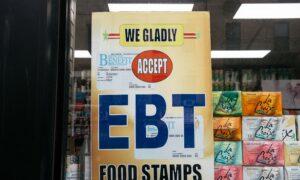More than 66,000 people stayed on food stamp rolls even after winning enough money in lotteries to make them ineligible—and that’s based on data obtained in just 13 U.S. states—with the figure for all 50 states “likely in the hundreds of thousands,” a government watchdog has revealed.
The Foundation for Government Accountability (FGA) submitted Freedom of Information Act (FOIA) requests to all 50 states, seeking information on the number of people in the food stamp program since 2019 who won big in the lottery, according to Hayden Dublois, the FGA’s data and analytics director.
Through a combination of state negligence and federal loopholes, more than 66,000 substantial lottery winners continued to receive food stamps in the 13 states for which the FOIA request yielded survey data, he said.
“Across all 50 states, the number is likely in the hundreds of thousands,” Mr. Dublois said, with the stark figures being the latest sign of persistent food stamp program abuse about which the FGA has been sounding the alarm for a long time.
“Congress should get lottery winners off this low-income program when passing the Farm Bill later this fall,” he said.
The Farm Bill package, which is renewed about every five years, determines policy around various programs, including the food stamp system.
Some Republicans have sought to reform the food stamp system to avoid abuse. Rep. Ben Cline (R-Va.) introduced a bill earlier this year called the No Welfare for the Wealthy Act, which seeks to set more stringent asset and income thresholds for people to qualify for food stamps.
The measure would end broad-based categorical eligibility (BBCE) for the food stamp program, which the FGA says is a loophole that lets states ignore income and asset thresholds to expand eligibility to wealthier people who normally wouldn’t qualify.
Food stamp reform is a contentious issue on Capitol Hill.
Loophole in Focus
In the past several decades, food stamp enrollment has skyrocketed.In 2000, there were 17 million people on the rolls, according to U.S. Department of Agriculture data. By 2023, that number had swelled to 42.4 million.
Part of the problem, according to the watchdog, is that 41 states and the District of Columbia ignore the federal income and asset limits, letting millions of ineligible enrollees keep getting food stamp benefits while opening the system to waste, fraud, and abuse.
Roughly 5.4 million food stamp recipients who enrolled through BBCE don’t meet eligibility requirements because states have used federal loopholes to overlook eligibility criteria, according to the FGA.
Households that managed to qualify under BBCE were nearly three times as likely to have payment errors than other households, according to the FGA study.
“With it being a Farm Bill year, Congress has an opportunity to close this loophole for good,” the watchdog stated in a note. “Eliminating the BBCE loophole could save taxpayers an astounding $112 billion over the next decade and help restore program integrity.”
Known as the “Snap Back Inaccurate SNAP Payments Act,” her legislation would slash spending by nearly $1 billion a month by ensuring that all errors—regardless of the amount—be counted.
The measure would also hold states accountable for payment errors and direct state governments to stop giving benefits to people who are ineligible.
Food Stamp Expansion Blamed for 15 Percent Rise In Grocery Prices
An earlier FGA study blames increased food stamp spending—including a massive expansion of the program under President Joe Biden—for contributing to soaring grocery prices.In 2021, under the Biden administration, the U.S. Department of Agriculture (USDA) introduced updated nutritional guidelines for federal food stamp benefits. These changes led to a roughly 27 percent expansion of SNAP as compared with its pre-COVID-19-pandemic scale.
This increased food stamp spending has, in turn, led to a whopping 15 percent (at minimum) jump in grocery prices, according to the FGA report.
“Grocery prices have risen by at least 15 percent due to increases in food stamp spending,” the watchdog stated in the report, which estimates that repealing President Biden’s 2021 food stamp expansion could save taxpayers more than $190 billion over the next decade.
The White House and the USDA didn’t respond by press time to requests for comment about the FGA’s findings linking food stamp spending to grocery inflation.
The note blamed a variety of factors for “higher than normal” grocery inflation, including “pandemic-induced shifts in food demand from restaurants to groceries, global supply chain bottlenecks, and unforeseen supply shocks like avian flu, the war in Ukraine, and poor weather.”
The CEA didn’t mention food stamp policy as a factor helping to fuel inflation.







